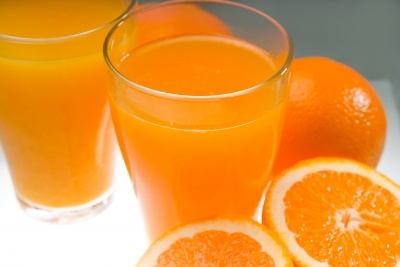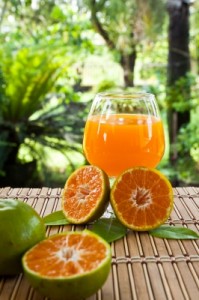
Naringin (4,5,7,-Trihydroxy flavonone-7-rhamnoglucoside) is one of the key bitterness compounds in citrus juices, mainly orange and grapefruit juice. Even though naringin has a number of nutritional benefits, processes have attempted to remove it so as to improve the sensory softness of orange juice. Most commercial methods debittering fruit juices, use ion-exchange resins. Recently, immobilizing the enzyme naringinase to a variety of supports has been demonstrated as an alternative. It’s a good example of how industrial enzymology has been exploited to improve juice quality by modifying its sensory characteristics (Ribeiro, 2011).
Naringase

Naringinase itself has a mix of activities – a rhamnosidase and γ-glucosidase activity and acts to hydrolyse naringin to the non-bitter aglycone naringenin. The enzyme itself is produced by Aspergillus niger fermentation (Bram and Solomons, 1965; Puri et al., 2005; Shanmugaprakash et al., 2011), from Penicillium spp. (Norouzian et al., 2000), and Staphylococcus xylosus MAK2 (Puri et al., 2011). The processes including its purification have been widely reported (Puri and Bannerjee, 2000). The enzyme has been immobilised to a variety of supports for use in column reactors: ionic binding to DEAE-Sephadex (Ono et al., 1977), tannin-aminohexyl linked cellulose (Ono et al., 1978), glycophase coated glass (Ono et al., 1978), chitin (Tsen and Tsai, 1988), alginate beads (Puri et al., 1996), to packaging film (Soares and Hotchkiss, 1998) and even covalently bound to woodchips (Puri et al., 2005).
The process suffers from some limitations. Notably, the products of the naringinase catalyzed reaction inhibit the enzyme and the blocking of the supports and the column by the substrate which is usually fruit juice. Fruit juice contains a number of fines and insoluble material, and clarification by a membrane process or decanter has had to be applied beforehand. Inhibitors are notably rhamnose and glucose (Manjón et al., 1985) as well as citric acid in juice, although there is a pH effect too (Ono, 1980). The latter sugar is a critical constituent in juice and its concentration is reflected in the juice brix. Approaches to removing the limitations include rapid removal of the inhibitors, redesign of the column reactors and modification of the feedstock as described above. The enzyme processing approach is one example of how a food stuff can be conveniently modified effectively and efficiently
References
Bram, B., Solomons G.L. (1965) Production of the enzyme naringinase by Aspergillus niger. Appl. Microbiol. 13 pp. 842–5.
Manjón, A., Bastida, J., Romero, C., Jimeno, A. and Iborra, J.L. (1985) Immobilization of naringinase on glycophase coated porous glass. Biotechnol. Letts. 7 pp. 477–482
Norouzian, D., Hosseinzadeh,A., Inanlou, D.N., Moazami.N. 2000. Production and partial purification of naringinase by Penicillium decumbens PTCC 5248. World J. Microb. Biotechnol. 16 pp. 471-473.
Ono, M. 1980. Inhibitory effects of citric acid in enzymic debittering of citrus fruit juice. J. Ferment. Technol. 58 pp. 387-389.
Ono, M., Tosa, T., and Chibata, I. (1978) Preparation and properties of immobilized naringinase using tannin-aminohexyl cellulose. Agric. Biol. Chem. 42(10): pp. 1847- 1853.
Ono, M., Tosa, T., and Chibata, I. (1977). Preparation and properties of naringinase immobilized by ionic binding to DEAE- Sephadex. J. Ferment. Technol. 55 pp. 493-500.
Ono, M., Tosa, T., and Chibata, I. (1978) Preparation and properties of immobilized naringinase on glycophase coated porous glass. Biotechnol. Letts. 7 pp. 477–482
Puri, M., & Banerjee, U. (2000). Production, purification, and characterization of the debittering enzyme naringinase. Biotechnology Advances, 18 pp. 207–217.
Puri, M., A. Banerjee and U.C. Banerjee (2005) Optimization of process parameters for the production of naringinase by Aspergillus niger MTCC 1344. Process Biochem. 40 pp.195-201.
Puri, M., Kaur, H., Kennedy, J.F. (2005). Covalent immobilization of naringinase for the transformation of a flavonoid. J. Chem. Technol. Biotechnol. 80 pp. 1160-1165.
Puri, M., Marwaha, S.S. and Kothari, R.M. (1996) Comparative kinetic characterization of soluble and alginate entrapped naringinase. Enz. Microb. Technol. 18 pp. 281–285
Puri, M., Kaur, A., Barrow, C.J., Ram, S.S. (2011) Citrus peel influences the production of an extracellular naringinase by Staphylococcus xylosus MAK2 in a stirred tank reactor. Appl. Microb. Biotechnol. 89(3) pp. 715-722
Ribeiro, M.H. (2011) Naringinases: occurrence, characteristics, and applications. Appl. Microb. Biotechnol. 90(6) pp. 1883-1895.
Shanmugaprakash, M., Vaidyanathan, V.K., Manickavassham, H., Vargese, M., Pothiyappan, K. (2011) Solid-state fermentation for the production of debittering enzyme naringinase using Aspergillus niger MTCC 1344. Engineering in Life Sciences 11(3) pp. 322-325
Soares, N. F. F., & Hotchkiss, J. H. (1998). Naringinase immobilisation in packaging films for reducing naringin concentration in grapefruit juice. J. Food Sci., 63, pp. 61-65.
Tsen, H.Y. and Tsai, S.Y. (1988) Comparison of the kinetics and factors affecting the stabilities of chitin immobilized naringinase from two fungal sources. J. Ferment. Technol. 66 pp. 193–198

Hey there! I’ve been following your weblog for a long time now and finally got the bravery to go ahead and give you a shout out from Dusseldorf! Just wanted to mention keep up the good job!
Hi – just wanted to know if this was an enzyme that you could use in other applications. I find some fruit juices just too bitter and I need to add loads of sugar. I have a very sweet tooth and I was looking on the internet for it as an ingredient. You could make quite a bit of money just selling this as a kit !